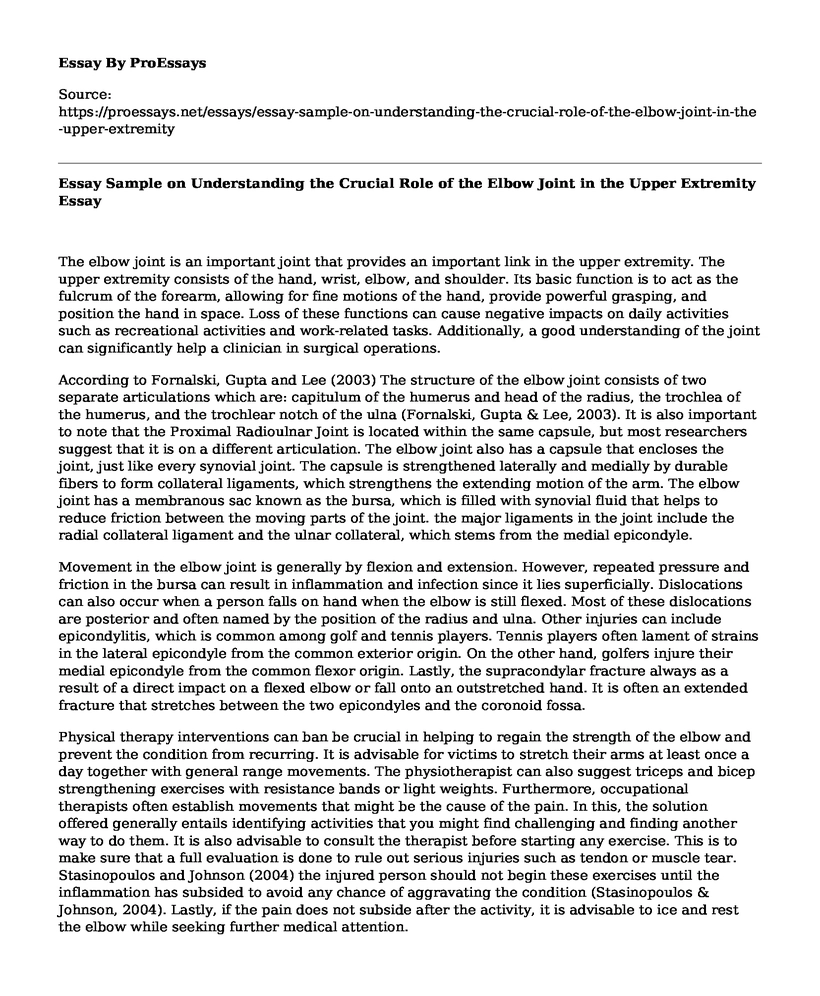The elbow joint is an important joint that provides an important link in the upper extremity. The upper extremity consists of the hand, wrist, elbow, and shoulder. Its basic function is to act as the fulcrum of the forearm, allowing for fine motions of the hand, provide powerful grasping, and position the hand in space. Loss of these functions can cause negative impacts on daily activities such as recreational activities and work-related tasks. Additionally, a good understanding of the joint can significantly help a clinician in surgical operations.
According to Fornalski, Gupta and Lee (2003) The structure of the elbow joint consists of two separate articulations which are: capitulum of the humerus and head of the radius, the trochlea of the humerus, and the trochlear notch of the ulna (Fornalski, Gupta & Lee, 2003). It is also important to note that the Proximal Radioulnar Joint is located within the same capsule, but most researchers suggest that it is on a different articulation. The elbow joint also has a capsule that encloses the joint, just like every synovial joint. The capsule is strengthened laterally and medially by durable fibers to form collateral ligaments, which strengthens the extending motion of the arm. The elbow joint has a membranous sac known as the bursa, which is filled with synovial fluid that helps to reduce friction between the moving parts of the joint. the major ligaments in the joint include the radial collateral ligament and the ulnar collateral, which stems from the medial epicondyle.
Movement in the elbow joint is generally by flexion and extension. However, repeated pressure and friction in the bursa can result in inflammation and infection since it lies superficially. Dislocations can also occur when a person falls on hand when the elbow is still flexed. Most of these dislocations are posterior and often named by the position of the radius and ulna. Other injuries can include epicondylitis, which is common among golf and tennis players. Tennis players often lament of strains in the lateral epicondyle from the common exterior origin. On the other hand, golfers injure their medial epicondyle from the common flexor origin. Lastly, the supracondylar fracture always as a result of a direct impact on a flexed elbow or fall onto an outstretched hand. It is often an extended fracture that stretches between the two epicondyles and the coronoid fossa.
Physical therapy interventions can ban be crucial in helping to regain the strength of the elbow and prevent the condition from recurring. It is advisable for victims to stretch their arms at least once a day together with general range movements. The physiotherapist can also suggest triceps and bicep strengthening exercises with resistance bands or light weights. Furthermore, occupational therapists often establish movements that might be the cause of the pain. In this, the solution offered generally entails identifying activities that you might find challenging and finding another way to do them. It is also advisable to consult the therapist before starting any exercise. This is to make sure that a full evaluation is done to rule out serious injuries such as tendon or muscle tear. Stasinopoulos and Johnson (2004) the injured person should not begin these exercises until the inflammation has subsided to avoid any chance of aggravating the condition (Stasinopoulos & Johnson, 2004). Lastly, if the pain does not subside after the activity, it is advisable to ice and rest the elbow while seeking further medical attention.
References
Fornalski, S., Gupta, R., & Lee, T. Q. (2003). Anatomy and biomechanics of the elbow joint. Sports medicine and arthroscopy review, 11(1), 1-9.
Stasinopoulos, D., & Johnson, M. I. (2004). Cyriax physiotherapy for tennis elbow/lateral epicondylitis. British journal of sports medicine, 38(6), 675-677.
Cite this page
Essay Sample on Understanding the Crucial Role of the Elbow Joint in the Upper Extremity. (2023, Mar 11). Retrieved from https://proessays.net/essays/essay-sample-on-understanding-the-crucial-role-of-the-elbow-joint-in-the-upper-extremity
If you are the original author of this essay and no longer wish to have it published on the ProEssays website, please click below to request its removal:
- The Biology Behind the Procedure
- Research Paper on Parts of the Digestive System
- Whether My Sense of Smell Affect My Sense of Taste? - Essay Sample
- Different Regulations of GMOs in Different Countries
- Essay Example on Revolutionizing Genome Editing: Introducing Prime Editing Technology
- Research Paper Sample on Electrolytes: Critical for Muscles, Nerves & Hydration
- Free Report Sample on Neural Network







